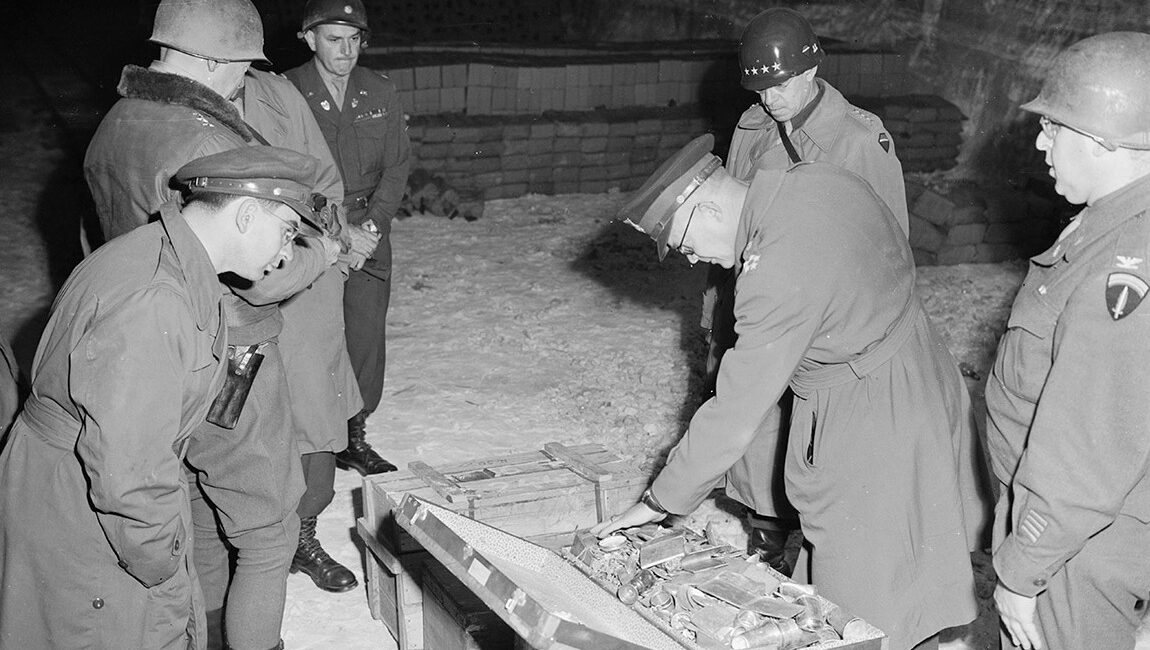Gold. It’s the precious metal that civilizations have vied for, sculpted with, and built their economies around. A metal so versatile that it’s malleable, ductile, and retains its sheen eternally, resistant to most chemicals. But there is one unique concoction that challenges this metal’s resistance: aqua regia.
The roots of aqua regia trace back to the 14th Century when an alchemist, assuming the identity of the renowned 9th Century scholar Jabir ibn Hayyan, stumbled upon its gold-dissolving properties. When nitric acid met ammonium chloride, they created this potent solution. Although initially viewed as a stepping stone to the elusive Philosopher’s Stone, aqua regia, formed today by combining nitric and hydrochloric acid, has practical applications. From etching metals, cleaning laboratory glassware to refining gold to unparalleled purity, its uses are diverse. Yet, in World War II, it played an unexpected and crucial role against the Nazis.
By the late 1930s, Nazi Germany’s insatiable hunger for gold, combined with their persecution of the Jews, led to the confiscation of significant quantities of gold, including Nobel Prize medals belonging to German scientists. The Nazis barred Germans from retaining Nobel Prizes after journalist Carl von Ossietzky, an anti-Nazi activist, was awarded in 1935. Consequently, scientists like Max von Laue and James Franck, both Nobel laureates, were at risk.
In a bid for safety, von Laue and Franck transferred their precious medals to Niels Bohr in Denmark. However, when Hitler’s army invaded Denmark in 1940, the challenge intensified. The solid 23-carat gold medals, with their laureates’ names engraved, couldn’t merely be hidden – they would be conspicuous trophies for the Nazis. That’s when George de Hevesy, a Hungarian chemist and future Nobel laureate himself, proposed a brilliant plan: use aqua regia to dissolve the medals.
Why does aqua regia work when other acids fail? The secret lies in teamwork. While nitric acid can oxidize gold, the reaction stalls due to saturation. However, when combined with hydrochloric acid, the two generate volatile byproducts like nitrosyl chloride and chlorine gas. This reaction allows the acid mixture to remain potent. As gold interacts with this concoction, chloroauric acid forms, ensuring the reaction’s continuity.
Despite this chemical know-how, dissolving the medals wasn’t swift. With the Nazi threat looming, de Hevesy had to patiently wait until the medals entirely dissolved into an orange solution. Once achieved, he cleverly camouflaged this beaker among other laboratory chemicals, which the Nazis overlooked, believing it was an ordinary solution.
Remarkably, after the war, the aqua regia solution with the dissolved medals stayed untouched in de Hevesy’s laboratory. Using iron chloride, he managed to extract the gold, which the Nobel Foundation later re-cast into Franck’s and von Laue’s medals. They were ceremoniously returned to their rightful owners in 1952.
The Fate of Europe’s Stolen Gold
During World War II, the Nazis executed one of the largest robberies in history, amassing approximately $600 million worth of gold, equating to a staggering $19 billion in today’s terms. By war’s end in 1945, the Reichsbank, in a surprising twist, possessed almost 300 tons of gold — even more than what it held at the war’s onset. Yet, post-war recovery efforts by the Allies resulted in a mere fraction being reclaimed. Only $18.5 million of the looted $240 million that neutral nations received in trade was returned to the Tripartite Gold Commission, with Sweden contributing almost $15 million of that sum.
Germany’s Deep-rooted Relationship with Gold
Germany, a nation known for its economic prowess, holds the second-largest gold reserves globally, surpassed only by the U.S. Federal Reserve. The foundation of this vast reserve lies in Germany’s economic miracle or the “Wirtschaftswunder,” which began in 1952. Additionally, Germany’s decision in 1931 to abandon the gold standard, marked by the Reichsbank suspending the Reichsmark’s convertibility, underscores the nation’s complex relationship with gold. The Deutsche Bundesbank’s hefty reserves are a testament to Germany’s commitment to both economic stability and diversification, symbolizing the country’s intent to safeguard its wealth for future generations.
The Impact of WWII on Financial Systems
World War II profoundly impacted global financial structures, with gold playing a pivotal role. Nazi Germany’s pilferage of European gold significantly altered economic dynamics. Post-war, the gold was meant to be distributed among the Tripartite Gold Commission — comprising France, Britain, and America. However, decades later, the ramifications of the war lingered, with Holocaust survivors seeking claims on gold stored at the Federal Reserve Bank in New York. The episode highlights the lasting consequences of war on national treasures and the intertwined relationship between tangible assets and geopolitical events.
Who Truly Owns Nazi-Looted Assets?
Amid the aftermath of World War II, the redistribution and claims over Nazi-looted gold have consistently posed ethical questions regarding rightful ownership. While the Tripartite Gold Commission, made up of France, Britain, and America, was tasked with this gold’s distribution, the presence of several million dollars’ worth of gold at the Federal Reserve Bank in New York became a focal point for Holocaust survivors and their descendants. The moral intricacies surrounding these assets, originating from the darkest chapters of history, open debates about justice, reparation, and the appropriate measures to ensure rightful restitution.
The Role of Neutral Nations
Throughout World War II, several nations declared neutrality, standing apart from the conflict. However, the wartime narrative reveals a murkier picture. With neutral countries receiving a substantial portion of the looted gold in trade, their role in indirectly supporting the Nazi regime comes into question. Were these nations merely protecting their interests and ensuring survival, or were they indirectly complicit in the Nazi war machine’s operations? This topic examines the blurred lines between passive participation and active complicity during times of global conflict.
World War II saw Switzerland maintain its neutral stance, but the nation’s banking system tells a different tale. Known for its secretive banking laws, Switzerland became a focal point for transactions related to Nazi-looted gold. The debate rages on: To what extent was Switzerland aware of the origin of these assets, and was the country’s financial system willingly or unknowingly aiding the Nazi regime? The discussion probes into the responsibilities of financial institutions during wartime and the ethical boundaries they may or may not cross.
Gold Standard vs. War Economy
The abandonment of the gold standard by several countries, including Germany, during the tumultuous 1930s marks a critical turning point in global financial history. With the impending threat and eventual outbreak of World War II, nations were forced to rethink their economic strategies to sustain war efforts. The discussion contrasts the pre-war gold standard with the wartime economy, emphasizing the adaptability of financial systems in the face of geopolitical upheavals and the long-term implications of such shifts.
While much attention is rightly given to the Holocaust victims in the narrative of Nazi-looted gold, there exist numerous unsung stories of other communities and nations that suffered. From art thefts to plundering religious institutions, the Nazi regime left no stone unturned in its quest for wealth. This topic delves deeper into the lesser-known tales of communities, cultures, and countries that bore the brunt of Nazi gold theft, emphasizing the multifaceted nature of World War II atrocities.
Thoughts on Dissolving Gold and the Nazis
In reflecting upon the intricate web woven by the looted gold of the Nazi era, it’s crucial to understand the depths of its impact, not merely on the global economy but on the lives of countless individuals. Each ounce of gold tells a story of pain, suffering, survival, and resistance. It’s a testament to humanity’s darkest hours, yet it also symbolizes the resilience of the human spirit.
- Transform Your Health with Medford Medical Weight Loss Program - June 9, 2025
- A Chat with Nate and Mika, Christian Wedding Photographers - July 18, 2024
- Ultimate Guide To Playing Online Casinos - May 27, 2024







